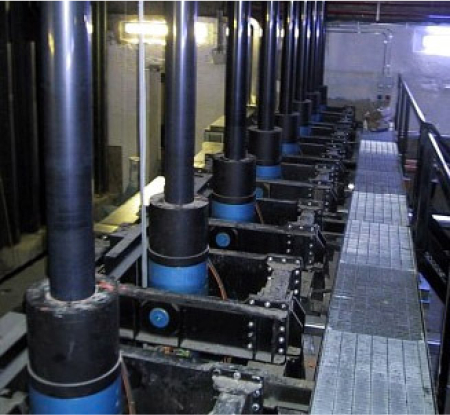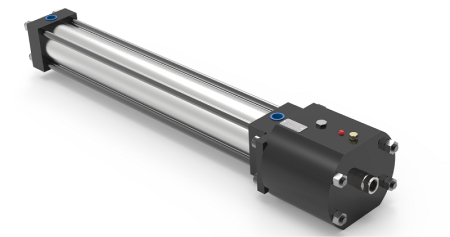
VP of Business Development—Rod Locks & Press Safety,
Machine Design Components
Office:
+1.815.316.5219
Email:
shane@ame.com

Product Manager, Rod Locks & Press Safety
Office:
+1.815.316.5217
Email:
nickroeling@ame.com
Power-off clamping is used to maintain position in the absence of pressure. In simple terms, it is a pressure to “Unlock” and spring to “Clamp” device. AMLOK and SITEMA locking devices are designed for both pneumatic and hydraulic operating systems. When pressure drops to zero, the clamp system is actuated by a set of springs.
Power-off clamping applications generally fall into two main categories: Safety catcher types to prevent “Gravity Fall” conditions, and “Position-and-Hold” types to maintain a precise position.
WHY POWER-OFF VS POWER-ON?
It’s not overtly apparent why removing power to engage a clamping mechanism is valuable. But, there are a few major reasons why power-off clamping is optimal when compared to power-on clamping.
Uncertainty for Safety
While we all know that life is full of uncertainty, as manufacturers, we try to avoid it at all costs.There is always the possibility of sudden power loss to your facility, your machine, E-Stop conditions or even the failure of fluid power components due to unforeseen circumstances. A power-on clamping system would fail in this situation. But a power-off clamping system is designed to remedy this, because the default condition is secure. Power-off clamping is designed to engage (clamp) when pressure is removed and release (unlock) when pressure is introduced. This allows the equipment to maintain axial position.
Repeatability
In the event of a power failure, a rod lock can retain the position of the cylinder rod within the movement tolerance. Without a rod lock, there is potential for the cylinder to over-travel or drift out of position. During machine recovery, the equipment may need to be moved back into position to start the next cycle. With a rod lock, this “recovery” movement would not be necessary. This is common in applications found in high-production rate facilities like automotive or packaging, where time and position is importnat.
Ease of Use
When power-off clamping systems are operating properly, the only element that experiences wear-and-tear are the seals of the hydraulic or pneumatic system.
The advantage of a power-off system is the clamping mechanism and it only releasing with fluid power. Because of this, it doesn't compromise the safety if there is a seal failure. If you’re using a power-on clamping system, the clamping mechanism would fail.
This makes the system more reliable and easier to use. It simplifies the safety element and makes the replacement of the sealing components more streamlined.

Cost-Effective
Power costs money. When leaving a machine (like an industrial press) overnight, it needs to be secured with a clamping system. If you’re using a power-off clamping system, no power is required to secure the overnight system. With a power-on clamping system, your machine will continue requiring power, even when not in use.
Another example of how power-off clamping can improve power consumption is if there is a cylinder stop during a cycle. If the cycle runs for 58 seconds and the clamp needs to be disengaged for two seconds, then you can limit the power use to just those two-second intervals. Whereas with a power-on system, you’d have to run power for 58 seconds of every minute.
Safety Devices for Gravity Fall Protection
Sitema safety catchers are used wherever heavy lifted loads must be secured against falling or accidentally dropping. The catchers are used where protection of personnel and accident prevention must be achieved. Catchers can control a falling mass at infinitely variable positions. Roughly 90% of safety catcher applications are for large industrial presses, which require a robust safety system.
Position and Hold Cylinders
Power-off clamping systems can also be used in a position-and-hold system as a cylinder attachment, like rod locks from AMLOK. Systems like this can adjust and hold location in both directions and hold position precisely at 0.002 - 0.003 in.
In some cases, where safety is paramount, combining both a safety catcher and an AMLOK-style rod-locking system creates redundancy, which can ensure compliance with the most stringent safety regulations while also allowing for position holding along the travel.
A reliability engineer would be able to leverage our solutions to create the best case for meeting the compliance requirements in their facility. In a nutshell, the application is what drives the decision between safety catcher and rod lock.

While power-off clamping is conceptually simple, picking the right device for your application is vital to not only precision, but also safety. Power-off clamping can create safe and precise value-adds while also reducing costs and simplifying your system. Fortunately, we’ve have resources and experts who can walk you through the process of choosing the power-off locking device that best suits your needs.
POPULAR USE-CASES FOR POWER-OFF CLAMPING
Obviously, power-off clamping has its advantages in a number of systems, but really, when do you need to use a power-off clamping system?
Tool Clamping for Metalworking Machines
Power drawbars in machine tool spindles, like in an OTT-JAKOB spindle drawbar system, are a perfect use-case. The springs in a power drawbar keep the tool holder clamped in the spindle shaft. Fluid power is only introduced to unclamp the tool during tool changes, which implies both the ease-of-use and cost-saving aspects of a power-off system.

Part Clamping for Machining Operations
Similar to power drawbars, zero-point locating fixtures used in machining set-ups benefit from a power-off system. These clamping stations are pneumatically unclamped when shop air is introduced. When the workholding fixture is placed in position and pneumatic power is removed, the clamping stations activate to pull down on the retention knob offering extremely rigid and micron-precise clamping and locating for highly repeatable machining operations.
